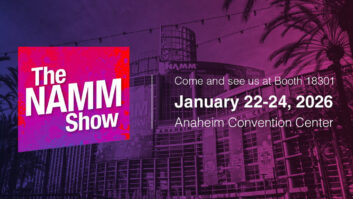Creative Labs has come up with another way to future-proof a solid-state-memory portable-audio device.
Its second-generation Nomad 2 will support MP3 and Windows Media Audio (WMA) playback when it ships in January at less than an everyday $400. But the device’s programmable processor and embedded flash memory will enable it to play back other formats if the company chooses to make the codecs available for the player, said senior VP C. Hock Leow. “It’s codec-agnostic,” he said.
Consumers would be able to download additional codecs to the portable through the supplied music-management PC software. Although the device will come with 64MB of embedded flash memory for storing music files, the codecs will reside in a separate level of flash memory, which could also be loaded at a later date with SDMI-compliant digital rights management software. The device will initially support WMA’s digital rights management technology.
“We plan to make the codec resident in the player, but you will be able to put in at least four codecs at a time, and the consumer can change the resident codec if he wants,” Leow said.
Like Thomson’s Lyra, its internal DSP is fast enough (processing about 100 million instructions per second) to potentially play back most, if not all, audio codecs currently flying around the Internet.
Thomson’s solution is similar to Creative’s, except that the codecs reside in removable 32MB and 64MB Compact Flash cards that also store music files. Because the codecs use up only about 45 to 70Kb per second of flash memory, each card can support multiple codecs along with multiple music files. Storage space will become even less of a consideration when Thomson ships a 300MB card as early as the end of the year.
In the Lyra, the proper decoder boots up when an MP3 or Real Audio G2 file is selected for playback. Supplied music-management PC software will transfer the appropriate codec to the cards when it detects an MP3 or G2 file extension on the music file being transferred.
Thomson hopes by the end of the year to announce support for additional formats. “We’ve tested five other codecs that will play on the Lyra,” said advanced audio group manager Jeff Scott. “Everything we know of today won’t be a problem.”
Sony adopted transcoding as the way to achieve codec-agnosticism in its planned Memory Stick Walkman, due in January at a suggested $399 with removable 64MB Memory Stick card (see October 11, p. 6). The supplied music-recording and -management software downloads and encodes MP3 files, then transcodes the file into Sony’s proprietary ATRAC3 format before transferring them to a Memory Stick portable. Transcoding makes the portable compatible with other compression formats if Sony adds support for other formats in future versions of its PC software.
Philips previously announced that its planned solid-state portable will initially support multiple codecs and will be user-upgradable to play back additional codecs.
In outlining its product plans, Creative said codec programmability isn’t the only new feature that the Nomad 2 has that the $249-everyday Nomad doesn’t.
Both come with FM tuner, 64MB removable memory card, voice recorder, and optional docking station/recharger, but the existing Nomad features a parallel-port connection, whereas the new model comes with USB connector for typical transfer speeds of 4-5MB per second versus about 1.2MB per second. It also adds Mac compatibility to the original’s Windows 95/98 compatibility, will come in five to seven colors versus the original’s silver, and adds a bigger LCD and wired remote.
More important, Creative adopted Smart Media’s SSFDC (solid-state floppy disc card) format, making the cards compatible with the Smart Media slots in digital still cameras and other devices. Cards for the existing Nomad use Smart Media’s form factor and Creative’s proprietary software.













